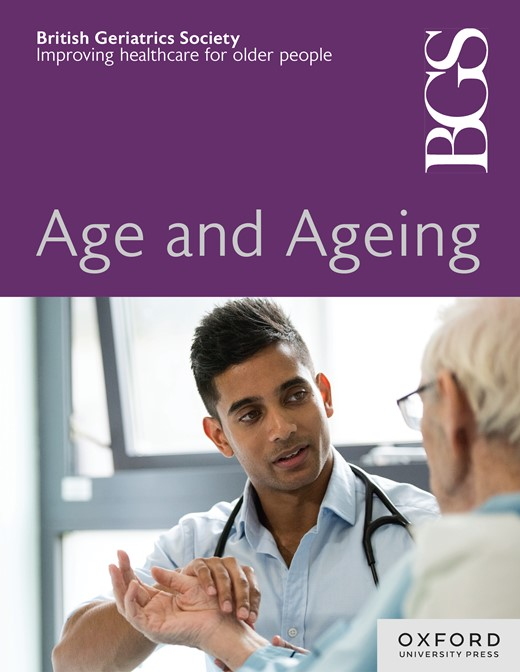在髋近端骨折的治疗中,早期老年干预和手术时间是如何相互影响的?
IF 7.1
2区 医学
Q1 GERIATRICS & GERONTOLOGY
引用次数: 0
摘要
手术时间(TTS)增加老年股骨近端骨折(pff)患者的死亡风险。正老年病护理途径减少死亡率和住院时间,但TTS和老年干预之间的相互作用仍不清楚。目的确定预测90天死亡率的组织变量(包括老年干预),并探讨它们与TTS的相互作用。材料和方法本回顾性研究包括7756例60岁以上的pff,他们在2005年至2017年期间接受了手术。影响90天死亡率(主要结局)的组织因素通过对数等级检验在管理数据库中确定。筛选了诸如在急诊科进行干预的流动老年医学小组(MGT)等变量。选定的变量与TTS和AtoG评分一起纳入Cox模型,AtoG评分是一种经过验证的多维预后工具(从0无合并症到≥5)。计算TTS与组织变量之间的统计交互作用。结果MGT是少有的具有保护作用的组织变量之一:风险比(HR) = 0.81, CI 95% [0.68 ~ 0.98], P = 0.03。MGT对TTS的影响在1 d内最强(HR = 0.70, CI95% [0.53-0.92], P = 0.01),超过2 d后减弱(HR = 0.97, CI95% [0.73-1.3], P = 0.08)。在AtoG评分≤2的患者中,MGT是最强的参数:HR = 0.76, CI95% [0.60-0.93], P = 0.03,而TTS的HR为1.01 CI95% [0.99;1.02], p = 0.15。在AtoG&;gt;2的患者中,MGT与降低TTS之间存在协同相互作用(P = 0.05)。结论老年干预可调节TTS对90天死亡率的影响,直至TTS为2天。MGT对易感患者和较粗俗患者均有积极影响。本文章由计算机程序翻译,如有差异,请以英文原文为准。
How do early geriatric intervention and time to surgery influence each other in the management of proximal hip fractures?
Introduction Time to surgery (TTS) increases mortality risk in old patients with proximal femur fractures (PFFs). Orthogeriatric care pathways reduce mortality and length of stay, but the interaction between TTS and geriatric intervention remains unclear. Objective To identify organisational variables—including geriatric intervention—that are predictive of 90-day mortality and explore their interactions with TTS. Materials and Methods This retrospective study included 7756 PFFs aged over 60 who underwent surgery between 2005 and 2017. Organisational factors influencing 90-day mortality (main outcome) were identified in an administrative database using log-rank tests. Variables such as a mobile geriatric team (MGT) intervening in the emergency department were screened. Selected variables were included in a Cox model alongside TTS and the AtoG score, a validated multidimensional prognostic tool (from 0 no comorbidity to ≥5). Statistical interactions between TTS and organisational variables were calculated. Results MGT was one of the rare organisational variables with a protective effect: hazard ratio (HR) = 0.81, CI 95% [0.68–0.98], P = 0.03. MGT’s strongest effect was for TTS up to 1 day (HR = 0.70, CI95% [0.53–0.92], P = 0.01) and then decreased beyond 2 days (HR = 0.97, CI95% [0.73–1.3], P = 0.08). In patients with an AtoG score ≤ 2, MGT was the strongest parameter: HR = 0.76, CI95% [0.60–0.93], P = 0.03, while the HR for TTS was 1.01 CI 95% [0.99; 1.02], P = 0.15. In patients with an AtoG>2, there was a synergic interaction between MGT and reduced TTS (P = 0.05). Conclusion Geriatric intervention modulated the effect of TTS on 90-day mortality up to a TTS of 2 days. MGT had a positive impact on both vulnerable and earthier patients.
求助全文
通过发布文献求助,成功后即可免费获取论文全文。
去求助
来源期刊

Age and ageing
医学-老年医学
CiteScore
9.20
自引率
6.00%
发文量
796
审稿时长
4-8 weeks
期刊介绍:
Age and Ageing is an international journal publishing refereed original articles and commissioned reviews on geriatric medicine and gerontology. Its range includes research on ageing and clinical, epidemiological, and psychological aspects of later life.
 求助内容:
求助内容: 应助结果提醒方式:
应助结果提醒方式:


